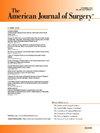欧洲疝气协会对腹壁重建患者生活质量的全面回顾性分析。
IF 2.7
3区 医学
Q1 SURGERY
引用次数: 0
摘要
简介:本研究旨在分析欧洲疝气协会腹壁重建术的生活质量(EHS-QoL):本研究旨在通过比较术前评分与术后1年和2年的评分,分析欧洲疝气协会(EHS-QoL)在腹壁重建中的生活质量:收集了 105 名复杂切口疝患者的术前、术后 1 年和 2 年的数据。统计分析包括三个 ART 方差分析模型,以比较三个时间点之间和每个时间点项目内的得分:EHS 评分从术前(Mdn = 57)到术后 1 年(Mdn = 10.5)和 2 年(Mdn = 8)均明显下降。最明显的变化发生在术前和术后 1 年的测量之间,尤其是在活动时的疼痛程度以及重体力劳动和外出活动的限制方面:结论:患者的生活质量在术后 1 年得到明显改善,部分患者的生活质量接近最高水平,这种改善在术后 2 年普遍得到维持或提高。本文章由计算机程序翻译,如有差异,请以英文原文为准。

Comprehensive retrospective analysis of the European hernia Society quality of life in patients undergoing abdominal wall reconstruction
Introduction
This study aimed to analyze the European Hernia Society Quality of Life (EHS-QoL) in abdominal wall reconstruction by comparing preoperative scores with those at 1 and 2 postoperative years.
Methods
Data from 105 patients with complex incisional hernias were collected preoperatively and at 1 and 2 years postoperatively. Statistical analyses included three ART ANOVA models to compare scores among the three time points and within each time point's items.
Results
The EHS score significantly decreased from preoperative (Mdn = 57) to 1 year (Mdn = 10.5) and 2 years postoperative (Mdn = 8). The most significant changes occurred between preoperative and 1-year measurements, particularly in pain levels during activities and limitations in heavy labor and activities outside the home.
Conclusion
Patients' quality of life notably improved at 1 year post-surgery, with some reaching near-maximum levels, and this improvement was generally sustained or increased at 2 years post-surgery.
求助全文
通过发布文献求助,成功后即可免费获取论文全文。
去求助
来源期刊
CiteScore
5.00
自引率
6.70%
发文量
570
审稿时长
56 days
期刊介绍:
The American Journal of Surgery® is a peer-reviewed journal designed for the general surgeon who performs abdominal, cancer, vascular, head and neck, breast, colorectal, and other forms of surgery. AJS is the official journal of 7 major surgical societies* and publishes their official papers as well as independently submitted clinical studies, editorials, reviews, brief reports, correspondence and book reviews.

 求助内容:
求助内容: 应助结果提醒方式:
应助结果提醒方式:


